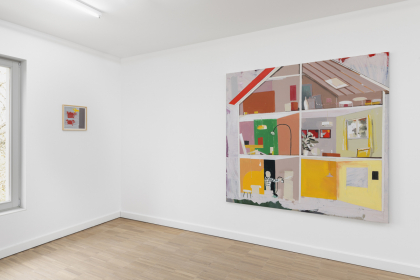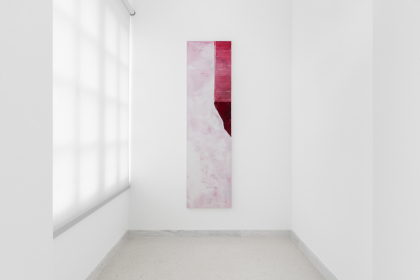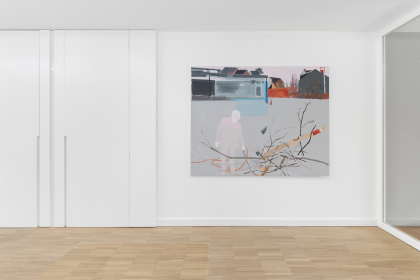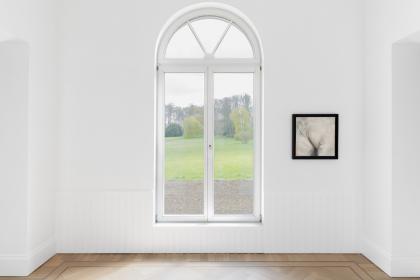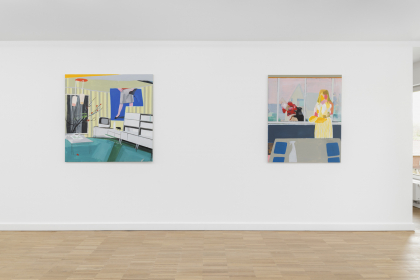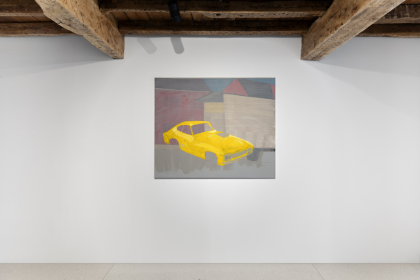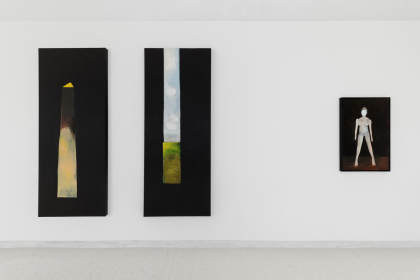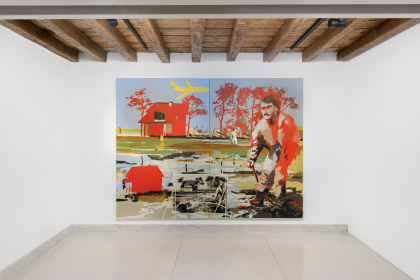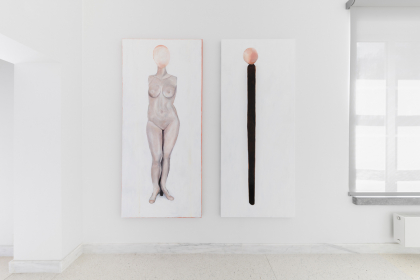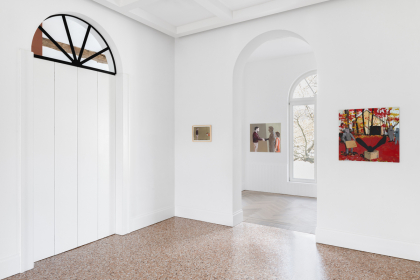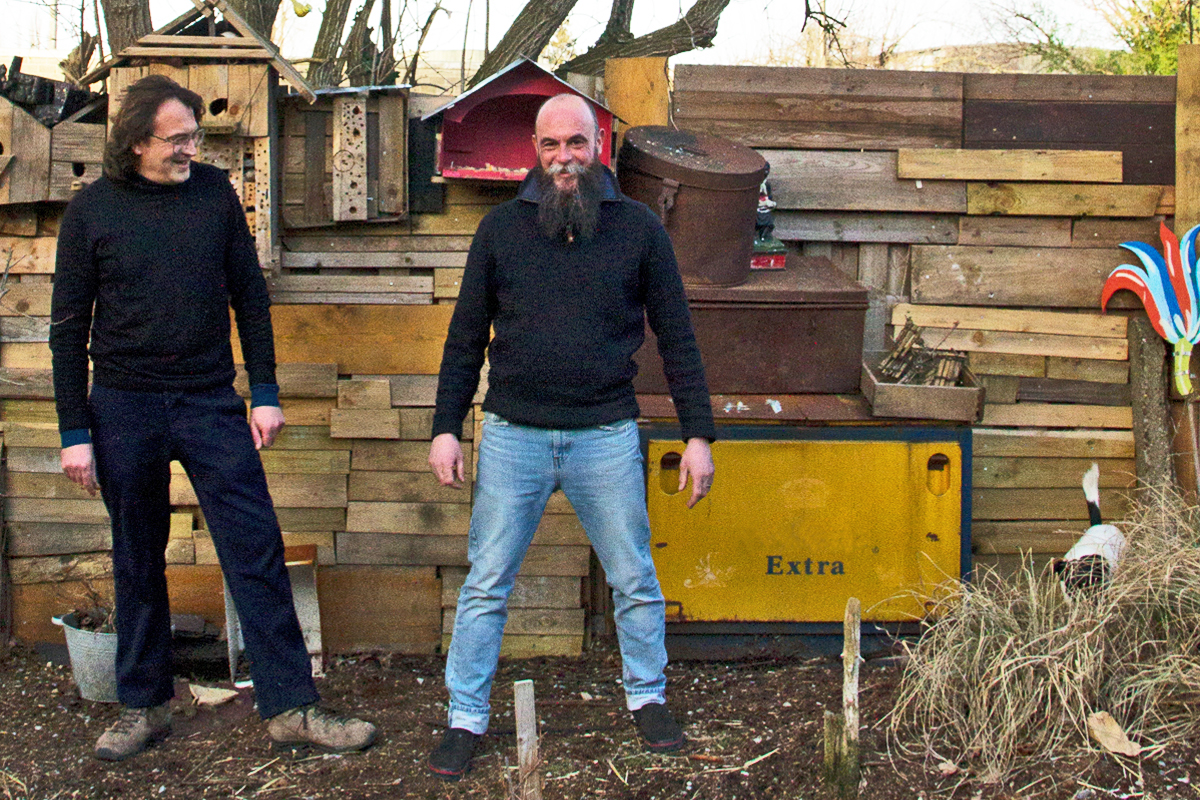
Let’s Sing Another Song
The exhibition ‘Let's Sing Another Song’ brings together two very different artists in a painterly dialogue, both on the cutting edge between figuration and abstraction, and each with a certain dose of reflection and humour.
Throughout his oeuvre, Tim Volckaert (1979) explores a spectrum of disciplines. The relationship between man and landscape runs like a thread through his actions, drawings, sculptures, installations, photography and paintings. How does man relate to his environment? And how is that reflected in art history? In a recent series of paintings, he analysed typical portraits (in the Renaissance and later) in which wealthy citizens allow themselves to be portrayed with a certain self-righteousness, against a landscape setting, which should primarily serve to further display their opulence. He deconstructed and corrected this duality earlier in mysterious paintings, in which foreground and background, and man and landscape merge harmoniously. In his latest works, Volckaert further reflects on how power structures – of man versus the environment, but also of people among themselves – are visible in art history.
In his BBC-series ‘Ways of Seeing’, John Berger describes how female nudes have existed in art history solely for the pleasure of the heterosexual male viewer, who can even own the work. Only very rarely do nudes, gracefully but passively displaying their bodies, look back at the viewer. On the other hand, there is a tradition of portraits of male leaders and prominent figures, brimming with an almost revolting display of power and ostentatious virility.
The emergence of such portraits from the Renaissance onwards parallels a growing drive for expansion and the conquest, and consequently subjugation, of the world by wealthy European powers. Many symbolic references to the virility of those portrayed creep into those paintings (intentionally or unconsciously): an obelisk in the background, a rearing horse, an outstretched sword - all relatively clear phallic shapes. A good example is the well-known ‘Bonaparte franchissant le Grand-Saint-Bernard’ by Jacques-Louis David (1801). Napoleon sits on a rearing horse and points upwards: he can conquer heaven, too. In ‘The Back King’ Volckaert isolates this upward movement.
Moreover, in similar ‘official’ portraits, the man’s genitals would often be very pronounced (although covered). Volckaert isolates such bulging, tight pants in ‘Napoleon’, which draws our attention to a bitter truth: (art) history, and by extension the whole world, is accommodatingly attuned to the heterosexual man. In that context he also evokes the theme of a female doll (is it a mannequin or a sex doll?) as the ultimate example of passivity and objectification.
Another, perhaps less obvious, witness of the urge to expand at that time is ‘Scène d'un Naufrage’ (better known as ‘The Raft of the Medusa’) by Théodore Géricault (1818-19). Here too, there is a clear upward movement in the composition. In the way a loose sail is twisted around the mast, Volckaert sees not only a phallic reference, but also an association with so-called "trouser painters": artists who, in the 16th century, were asked to cover the sex of previously painted nudes. He also studies this mast in several paintings as a sign of the ‘phallic’ power relations that lie behind the work and its story.
In a new series of paintings, which are not without reason elongated and vertical, Volckaert reveals, among other things, this mechanism in art history. The lack of a background makes the abstract image more pronounced. In ‘Monte Mentum’ and ‘Cutscape (the painting)’ a hint of a romantic landscape looms up like a phallic obelisk, the only shape left out against a black surface. Other works in the series echo the same form, but play with contemporary objects. A liberation can be felt in his letting go of all conventions of foreground, background, and perspective – the skills by which an artist could traditionally demonstrate his mastery.
Volckaert invites Thierry Grootaers (1974) to enter into a dialogue with his own work. Grootaers' paintings look very different: he works with bright, cheerful colours and a combination of figuration and abstract planes. He is interested in everyday scenes, such as interior views that radiate a homely atmosphere, but also allows human characters to enter the majority of his works. There is often a wittiness to them: they contain a wink, a joke, an unexpected element, or something that is not quite right.
The pleasure of painting is very clear with Grootaers. The pure, simple joy that drives him can be felt in every brushstroke, every colour area. The artist admits that he also enjoys the seemingly most banal things: preparing a canvas or painting a background. He works every day and always starts intuitively. While filling a colour plane, without any further plan, new ideas arise and he finds inspiration. The work develops by itself, the paint brings its own coincidences, little ‘accidents’ that guide the artist.
The vintage interiors, the collage-like juxtaposition of figures and background, the bright areas of colour – mainly red and yellow – are reminiscent of pop art. An important distinction, however, is the painterly gesture: the obvious brushstrokes that create a universe in thin but multiple layers, one on top of the other.
The characters who interact with each other or simply live in their own trusted environment - working in their garden, sitting at a table, dancing in the living room - breathe lightness. The images are harmonious, comfortable in their simplicity, satisfied and sometimes even downright optimistic. The work has a certain tenderness, in the way in which Grootaers allows his characters to lead a life of their own, but also in the winks he hides here and there; references to a film he saw, an inside joke that he shares with his own family, or – even more often – a reference to his own works. Sometimes the same character returns: there is one female figure, for example, that regularly seems to jump from scene to scene and from painting to painting.
There is no resentment or acrimony in the works, yet mystery does creep in here and there: in a subversive element or simply in a significant silence. An interior where the perspective is not quite right (Grootaers likes to mislead us in that regard) can also be very scary: a scene that awaits a crime, or that reminds us of terrifying interactions à la Lynch.
Sometimes he works again and again on the same canvas for years. On the back he always registers the date on which he works – a list that can span up to 15 years. Small or large gestures on the canvas are like a diary, records of small moments in life. They are inextricably linked to his personal memory and experience. These many reprises also make the previous lives of the canvas shine through in the surface: as the basis for the visible story, or as ghosts of a memory.
Grootaers paints figuratively, but also allows for a lot of imagination in intuitively chosen abstractions. For example, one part of an interior is left completely empty, or characters are not given a face. Some figures or objects remain a contour, and stand transparently against the background – phantoms that sharpen the sense of imagination and crank up the mystery. Moreover, these translucent factors cause foreground and background to merge and any sense of perspective to crumble.
It is in this reduction and in the abstract levelling of foreground and background that Volckaert and Grootaers meet each other. A comparison between the two artists is not quite relevant. They engage in a free dialogue, each in their own right, with their own methods, reflections and painterly arguments. They seem to be far apart, but every now and then their different rhythms do find a certain harmony.
Tamara Beheydt, March 2021


